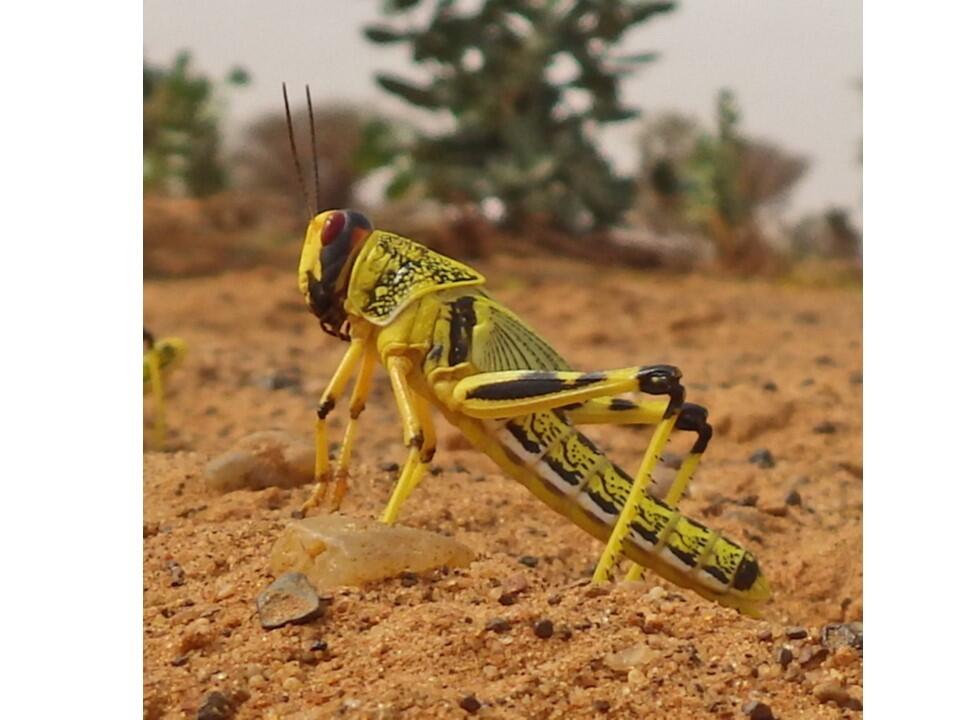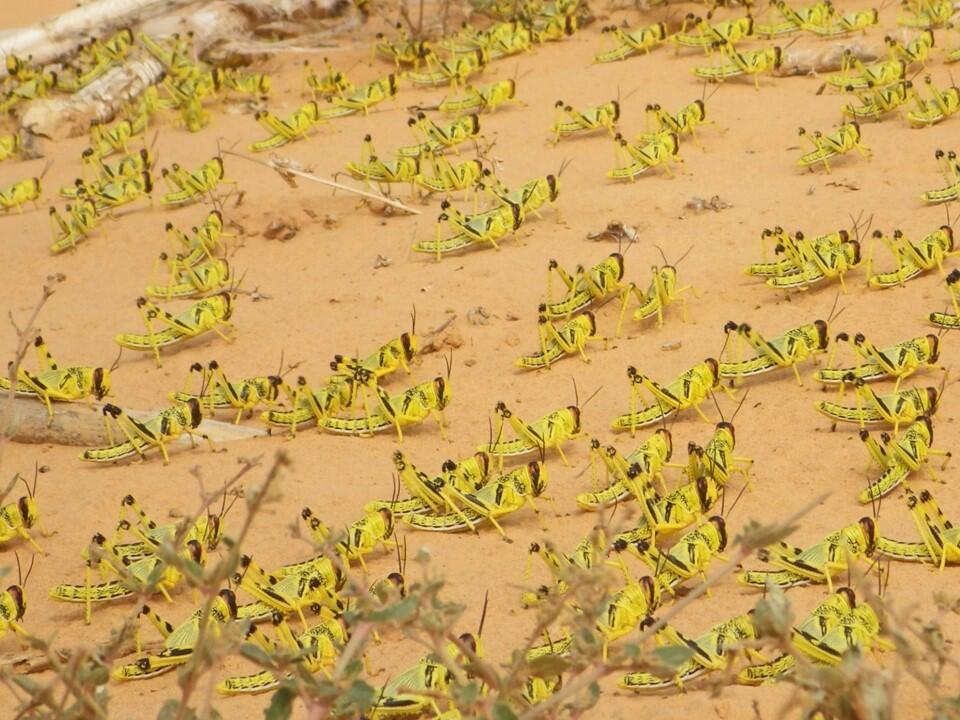Dr. Koutaro Ould Maeno, working as a Senior Researcher at Crop, Livestock and Environment Division, JIRCAS, together with the The Mauritanian National Desert Locust Centre (CNLA), the French Agricultural Research Centre for International Development (CIRAD), and the University of Melbourne, has reported that his research team has clarified how desert locusts, which cause plagues, migrate in groups and survive in harsh desert environments with large diel temperature differences *1. It was found that locusts behaviorally regulate their body temperature; they increase their body temperature when the ambient temperature is low and decrease their body temperature when the ambient temperature is high. The research team also built a model to predict locust's thermoregulatory behavior and body temperature based on their data. They confirmed that behavior could be predicted by estimating the body temperature of locusts from globally available environmental data. It is expected that this technique can be applied to improve forecasting accuracy of locust outbreaks. These results were published in the international scientific journal "Ecological Applications."
Desert locusts inhabit semi-arid areas from West Africa to India and often form into swarms. They can eat more than 500 species of plants, causing severe agricultural damage across borders. They are about 7 cm in length and become adults after molting five or six times. When they grow in high density, they express phase polyphenism; they display conspicuous yellow with black dots when they are gregarized*2. Gregarious nymphs aggregate with each other and actively move in groups. Gregarious adults migrate over distances of more than 100 km per day. Conversely, locusts that develop at low densities (The so-called "solitarious phase") have a green body and avoid one another. Food shortages can cause famine and conflict; hence, locust control is an urgent issue for countries in these regions. However, outbreaks are irregular and the deserts in which they occur are vast, making outbreak control difficult.
To mitigate damage, it is necessary to predict outbreaks and control them before the locusts become adults that fly long distances. However, most of the research to date has mainly involved breeding experiments in laboratories, etc. There have been very few field surveys of desert locusts; hence, their ecology in the wild is still unclear. Therefore, in this study, the research group conducted a field survey of desert locusts inhabiting the Sahara Desert of Mauritania, West Africa. Specifically, from November 10th to 27th, 2016, the researchers observed the diel behavior of gregarious nymphs that actively move in groups almost every day. The body temperature of the locusts and the surface temperature of the surrounding area were measured using a thermal infrared camera. The researchers investigated the relationship between behavior, body temperature, and ambient temperature. The ambient temperature range was 14.3- 38.7°C, and the ground temperature range was 11.5-56.4°C.

Credit:JIRCAS
As a result, it was found that desert locust on the ground at low temperatures in the early morning, warm their bodies by performing "group-basking behavior" that increases the surface area of their bodies exposed to the sun. Additionally, while many animals in the Sahara Desert are nocturnal, thereby avoiding exposure to high daytime temperature, locusts actively moved during the daytime. It was found that, when the temperature rose, locusts regulated their body temperature to avoid overheating. They would face the sun to reduce the surface area of their bodies receiving direct sunlight, and would perform "stilting behavior" to move their bodies away from the hot ground surface. During these periods, even if the ambient temperature was as high as 45-55°C, locusts were able to maintain their body temperature at approximately 40°C. It was also observed that digestion is accelerated by maintaining high body temperature. Around dusk, when the temperature dropped, they began the "group-basking behavior" again to warm their bodies. They climbed tall plants before sunset and remained there until early morning. Locusts altered their behavior throughout the day, migrating and feeding in a cyclical manner. Large amounts of food were retained in their foregut throughout the day.

They stretch out to keep their bodies away from the hot ground surface.
Credit:JIRCAS
From this, it was hypothesized that locusts accelerated digestion by maintaining a high body temperature, enabling them to grow efficiently and promote the growth of large numbers of gregarious locusts. In addition, the research group built a model for predicting locust body temperature and behavior by incorporating data related to ambient temperature, body temperature, and thermoregulatory behavior into an existing model (NicheMapR) that predicts microclimate and activity. By inputting the globally available environmental data of the survey site, it was confirmed that the ambient temperature and body temperature of the locusts could be estimated. Accordingly, their behavior (inactive, basking, and foraging) could also be predicted. Dr. Maeno said, "In the future, we would like to continue field surveys to understand the behavioral patterns of nymphs and adults under natural conditions. For the adults especially, I hope that through thermoregulatory behavior, it will be possible to predict the onset of flying, travel distance, landing locations and other relevant data."
- * 1 Diel temperature is the 24 hour period including both a day and the adjoining night
- * 2 Gregarious Phase refers to the physiological and behavioural changes that occur when locusts are forced to crowd together.
This article has been translated by JST with permission from The Science News Ltd.(https://sci-news.co.jp/). Unauthorized reproduction of the article and photographs is prohibited.




